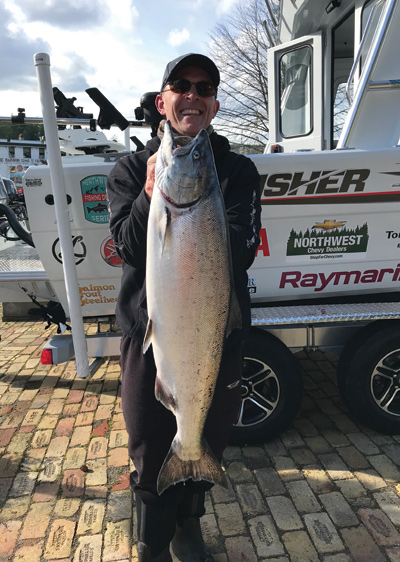It’s a very important time for salmon anglers as we’re within days of the final outcome of the 2020-2021 salmon fishing season setting process that will determine where we can fish and the amount of our salmon catch. While we await the verdict, issues are still being hashed out in meetings between state, federal and tribal co-fishery managers, as well as sport and commercial fishing constituents.
Each group is vying for fishing opportunities, but also focusing on the bigger picture of conserving wild salmon stocks that are protected under the federal Endangered Species Act. There is also a myriad of other issues ranging from killer whales and pollution runoff to habitat restoration and protection.
Once it’s signed, sealed, and delivered around April 10, the paperwork will be my roadmap on where to go salmon fishing this summer and fall. In early March, the public had their first glimpse of forecasts showing the salmon returns are down across the board, a trend dating back to 2016.
“For Puget Sound Chinook, we’re a little lower on certain stocks, but general numbers of hatchery returns are about where they have been,” said Mark Baltzell with the Washington Department of and Wildlife’s (WDFW) Puget Sound Salmon Fisheries Management. “The overall Puget Sound summer/fall Chinook forecast is 256,821 (38,516 are wild) in 2020, and slightly up from 246,837 (29,796) and 255,219 (27,404) in 2018.”
Baltzell noted concerning trends for key Puget Sound salmon stocks that drive the season setting process. Some, like the mid-Hood Canal Chinook stocks, are quite alarming with just 39 Chinook forecasted to return in 2020 compared to 286 in 2019, while a Stillaguamish predicted return of 901 Chinook is up from 888 in 2019. The Puget Sound Coho return is expected to see a dip in 2020, with a forecast of 523,498 compared to 708,521 in 2019.
Recalibrating Expectations

Migrating Chinook generally return to Puget Sound from June through September, while the coho timing is mid-summer through November. The preliminary Columbia River Chinook return looks rosy on paper with computer-generated forecasts. In the past few years, those returns were dismal when fish were dealing with in-river drought conditions and the “Blob” in the Pacific Ocean.
An estimated 430,000 Columbia River fall Chinook are expected in 2020 compared to 340,400 predicted and an actual return of 375,700 in 2019, and 365,600 predicted and 290,900 actual return in 2018. The upriver bright Chinook make up the bulk with a 2020 forecast of 233,400 compared to 158,400 predicted and 212,200 actual returns in 2019. The lower Columbia River “tule” hatchery Chinook (a driver for ocean salmon fisheries) is predicted at 51,000—down from a forecast 54,500 but up from actual return of 48,900 in 2019.
On the Washington coast, the Willapa Bay Chinook forecast is up with 31,185 compared to 28,100 in 2019. This is a popular inner-bay fishery from August through Labor Day weekend.

A low coho forecast of 268,700 is expected to arrive off the Washington and Oregon coast compared to a preseason forecast of 1,009,600 last year and an actual return of 408,100 in 2019. Of that, around 181,000 are predicted to turn the corner at Cape Disappointment and head up the Columbia, which in general could be a disappoint for summer ocean-bound salmon anglers.
While there’s a lot of scientific-based facts put into the salmon forecasts, anglers need to remember it’s a “wait and see game” and only time will tell how things pan out once fish return. The Pacific Fishery Management Council will adopt final season regulations via webinar on April 3-10. For details, go to wdfw.wa.gov/fishing/management/north-falcon/public-meetings.
Spring Fishing Options
Break out of the winter doldrums and get the boat on the water for decent early spring salmon fishing opportunities. These include the western Strait of Juan de Fuca (Area 5), which is open for hatchery Chinook fishing through April 30, and the eastern Strait (Area 6) open through April 15; San Juan Islands (Area 7) and northern Puget Sound (Area 9) are open through April 15. The south-central Puget Sound (Area 11), Hood Canal (Area 12), and east side of Whidbey Island (Areas 8-1 and 8-2) are open through April 30. Southern Puget Sound (Area 13) is open year-round. Central Puget Sound (Area 10) is closed for salmon and should reopen later this summer.
Salmon aren’t the only noteworthy fish species to catch.
The coastal lingcod fishery is open off Ilwaco, Westport, La Push, and Neah Bay west of the Bonilla-Tatoosh boundary line. Areas east of Bonilla-Tatoosh open April 16. Many inner-Puget Sound areas open May 1.
The eastern Strait of Juan de Fuca and most of Puget Sound open for halibut on April 16, earlier than in past years when the season didn’t begin until early May. The western Strait, Ilwaco, La Push, and Neah Bay opens April 30 for halibut. For dates on when fishing is open or closed and regulations, visit wdfw.wa.gov.
Sadly, the details of the spring fishing derby season are unclear at the time of this writing due to the COVID-19 oubreak. For details on what events may be happening or the status of events you were planning to go to, visit NWFishingDerbySeries.com.


